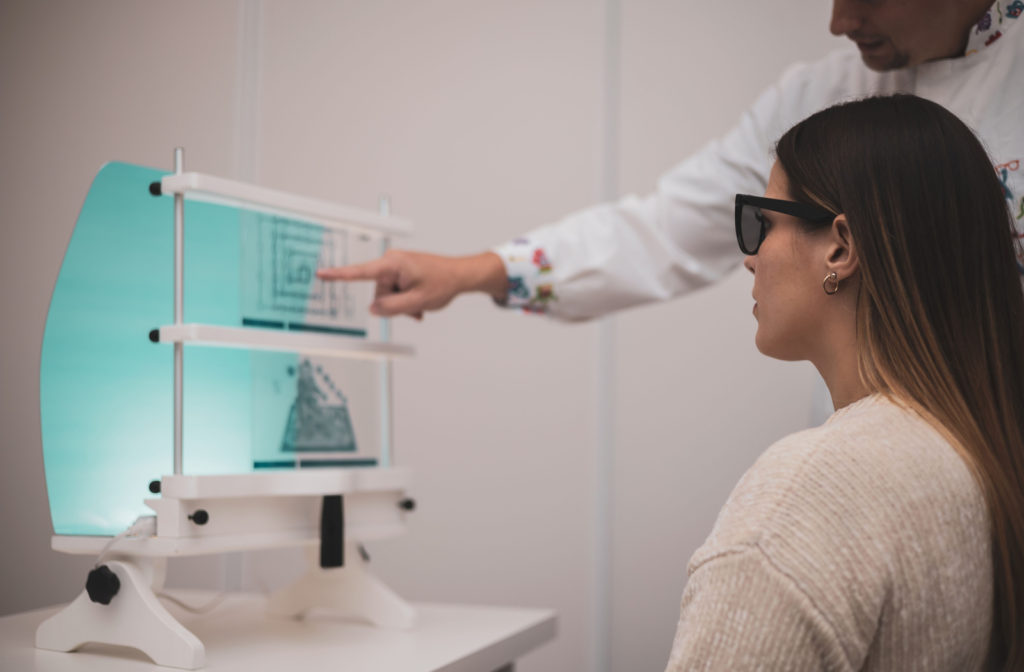If you’ve ever tried to focus on a nearby object and seen two images of it instead of one, you may be experiencing double vision. This is a common vision problem and can be caused by a range of eye conditions. Fortunately, many cases of double vision can be fixed through vision therapy.
During vision therapy, an optometrist or trained therapist will assign a series of exercises and programs to help train your brain and eyes to work together properly. They’ll likely recommend:
- Tracking exercises
- Pencil exercises
- Distant focusing exercises
These vision therapy exercises aim to help the brain learn to focus on objects at different distances and maintain the focus while the object moves, with the end goal of stopping your double vision.
What Is Vision Therapy?
Vision therapy is sort of like physiotherapy for your eyes. It’s a specialized approach to solving certain visual problems and aims to enhance your visual skills.
Optometrists often recommend vision therapy to treat vision problems that can’t be corrected with eyeglasses or contact lenses. This can be particularly useful for people struggling with eye movement, coordination, and their ability to focus on objects, or with conditions like:
- Amblyopia (lazy eye)
- Strabismus (crossed eyes)
- Binocular vision problems
- Visual problems after a brain injury
It can be particularly useful for people experiencing double vision, as this is often caused by the eyes being unable to work together properly.
How Does Vision Therapy Work?
Vision therapy aims to strengthen the connection between the eyes and the brain—alongside how well your eyes work together. By following a program consisting of different exercises recommended by an optometrist or vision therapist, you can train your eyes to overcome certain problems like double vision or visual alignment issues.
This program consists of a series of sessions with a vision therapist. They’ll guide you through various tasks and exercises that challenge your visual capabilities. These exercises typically include:
- Tracking moving objects
- Changing your focus between objects at different distances
- Carefully coordinating eye movements
- Maintaining focus for an extended period of time
Your vision therapist may offer more challenging exercises as you progress through therapy. As your brain learns to adapt to new information and movements in the eyes, you should notice improvement within a few months.
This can be extremely useful for people experiencing double vision!

What Causes Double Vision?
Imagine your eyes as if they’re two cameras constantly taking pictures of the world around you. These images are sent to the brain, where this information is converted into a single image. But when a problem develops, this conversion doesn’t happen properly. Whether this is a problem with how your eyes align or how the brain interprets visual information, it causes double vision.
Simply put: double vision, also called diplopia, is a condition where you see two images of an object rather than one.
Fortunately, this problem can be addressed by training the eyes and brain to properly interpret your visual information. However, it’s important to note that every person’s eyes are different, and results may vary on a case-to-case basis.
What Eye Exercises Should You Do for Double Vision?
When addressing double vision, there are a few eye exercises that may be recommended by an optometrist or vision therapist. Remember, though, that consistency is key when performing any visual exercises. The more your brain actively tries to perform these exercises, the more likely it is to adapt to processing visual information.
Your vision therapist can create a customized treatment plan based on your specific vision needs, but some common exercises for double vision include pencil, distance, and tracking exercises.
Pencil Exercises
Hold a pencil at arm’s length, and try to focus on the written numbers or letters on the side of the pencil. Then, slowly bring it closer to your nose, focusing on these symbols. Stop once you notice any doubling of the pencil or letters, and repeat the exercise from the beginning. This can help train the eyes to focus on small objects near the face.
Distance Exercises
Choose a nearby object and a faraway object, preferably at least 10 feet apart or more. Try to focus on the nearby object and hold your focus on it for a few seconds.
Then, alternate to the distant object. Do the same—focus for a few seconds, then switch back. As you switch between them, your brain should begin to automatically eliminate double images.
If you notice this exercise isn’t working, it can help to change the distance of the objects you’re looking at. Consistency is key here. Once you find a distance that works and your brain begins to see the objects as single images, start changing the distance of the objects to keep training your eyes.
Tracking Exercises
Choose a small object, like a pen, a coin, a cup, or even your finger. Begin by keeping it in the center of your vision and focus until it’s a single image, then begin slowly moving it in different directions.
Move it up, down, left, and right, but make sure you do this slowly. If you begin to notice double vision, start again and repeat the exercise slower.
As you get more comfortable with this, you can increase the speed to help improve your brain’s ability to track moving objects as a single image.
Vision Therapy in San Diego
If you’re experiencing double vision and are in need of vision therapy, contact our team at Total Vision Rancho Bernardo. Our optometrists and vision therapists are here to help you and can design a program to help you coordinate your eyes and brain to improve your visual abilities. Book an appointment with us today!



